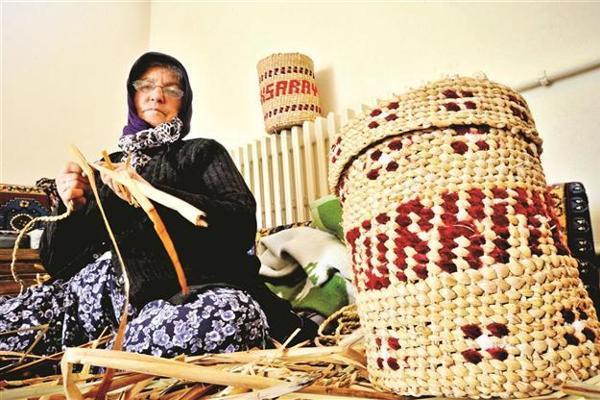Cappadocia aims to revive basket tourism
AKSARAY - Anatolia News Agency


Wicker baskets are weaved with a technique unique to the Cappadocia region. They are now being redesigned by women and used for different purposes. AA photo
The wicker basket industry, which has hundreds of years of history in the Central Anatolian region of Cappadocia, is being revived.According to the province of Aksaray’s Gülağaç district administrator Harun Yücel, wicker baskets are weaved with a technique unique to the region and have been produced for centuries. “The wicker basket is a handicraft continuing in the Gülağaç, Gülpınar, Demirci, Bakırlar and Sofular districts. This handicraft has survived as mothers teach this technique to their children,” Yücel said, adding that the Gülağaç wicker baskets were generally produced in a wetland area called the Karasu River Basin.
He said the baskets were generally used by locals to keep their legumes in, but with the increase of plastic baskets in recent years, such wicker baskets were almost forgotten.
“The Gülağaç wicker baskets used to be preferred because they can keep legumes for a long time without them rotting, thanks to its natural structure and knitting technique as well as its cultural value. But in recent years, plastic baskets began to replace wicker ones and this art has become uneconomical. This is why the number of people making them began to decrease. In order to revive this almost forgotten handicraft, to keep it for future generations and to present it to people as a touristic value, we have initiated a project. In collaboration with the Gülağaç Public Education Directorate, courses have been opened and many people have begun to learn this art again,” Yücel said.
He said that with the support of the Ahiler Development Agency, they had completed the project to bring Gülağaç wicker baskets back to boost tourism. Some 24 women have taken courses as part of the project, a website was constructed for its promotion, and 1,000 magazines have been printed.
New product in Cappadocia tourism
Yücel said that following the project, women who attended the course continued working under the roof of the association they had formed.
“With all these works, Gülağaç wicker baskets are being brought back to Cappadocia tourism. The baskets are redesigned and used for different purposes according to their size, such as to hold legumes, pencils and pens, laundry baskets, etc. We have also started working to sell them in the Ihlara and Manastır valleys, which are mainly visited by tourists,” he said.
As for how the baskets are made, Yüzel gave a detailed description. “Reeds are cut in reed beds and left to fry for two weeks. One day before starting the work of knitting, the reeds are getting wet. They are tied to each other in shape of plait, and ropes named ‘tura’ are produced. Around 20-50 turas are attached to each other and the skeleton of the basket is thus created. Then the basket is knitted, with designs created from pieces of cloth. According to needs, covers can also be produced for these baskets,” he said.
